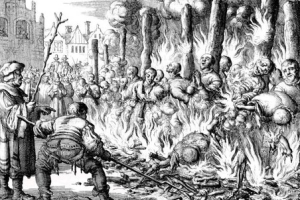Within the opening chapters of my book, Burning Blood, the witch Aurelia finds herself about to be burned at the stake.
‘Witch, you have been tried and convicted under the benevolent will of God. You are a consort of Satan and shall burn at the stake. Repent now and God may have mercy on your soul. Fail to repent and you shall writhe on that stake just as you shall writhe for eternity in the pits of Hell!’
The rough rope grazed her neck as it tightened, ready to take away her breath and leave nothing but an empty shell to cook in the flames. The cross danced in front of her face, with Christ’s tortured body hanging limply on it, the crown of thorns cutting painfully into his forehead.
‘Bring the flames and let that be the end of it,’ she intoned, her voice cutting through the rabble’s clamouring.
But while we all know witches get burned, what else do we know about this horrific method of execution and the people condemned to suffer it?
1. It was a punishment especially concerned with the ladies
 While heretics and witches were often destined for the purifying flames, women committed of particularly heinous crimes, like killing their husbands or high treason, were bound for the stake because it was said to protect their modesty. Sir William Blackstone, at the time, phrased it, ‘for the decency due to the sex forbids exposing in public mangling their bodies.’ Men? The hangman’s noose and the disemboweller’s knife were perfectly fine for them but the women were destined for the demure nature of the fire.
While heretics and witches were often destined for the purifying flames, women committed of particularly heinous crimes, like killing their husbands or high treason, were bound for the stake because it was said to protect their modesty. Sir William Blackstone, at the time, phrased it, ‘for the decency due to the sex forbids exposing in public mangling their bodies.’ Men? The hangman’s noose and the disemboweller’s knife were perfectly fine for them but the women were destined for the demure nature of the fire.
2. Not everyone was alive when they burned
The condemned woman would be bound to the stake with a rope or chain around their neck, or positioned on a stool. The fire would be lit but before it caused any harm, the noose or chain would be tightened, or the stool kicked away, and she would be strangled before the fire got hold of her. In some instances, the executioner would also deliver a few strikes to her breast to hasten her demise. Not everyone was so fortunate, however.
In the case of Catherine Hayes, executed on 9 May 1726, the fire ignited much quicker than expected and the executioner was unable to strangle her in time. She writhed in agony and more faggots were thrown on to the fire to speed the process. It took three hours for her body to turn to ash, though there’s no telling how long it took for her to die.
3. Some went out with a bang
As a merciful consolation to some men who were being burned at the stake (mostly heretics), they were given bags of gunpowder to tie between their legs and under each arm. Those lucky enough to have well-lit fires soon met an explosive end, meanwhile others weren’t so fortunate. When the wood was too green or the wind too strong, the men would often writhe for quite some time before a helpful soul or the right leap of flame brought an end to their agony.
4. Burning at the stake didn’t go out of fashion all that long ago
St Alban was one of the first notable people to be burned at the stake, and that took place in AD 304. The practice then enjoyed a long period of fervent approval as a method for dealing with heretics, witches and other sorts of people, but if you thought it was just a medieval practice, you’d be wrong.
While the last man to be burned alive for heresy in England, Edward Wightman, was executed in 1612, a witch was burned at the stake in 1708. And to the country’s north, Rebecca Downing was burned alive in Scotland in 1782 for poisoning her master. The last woman to die in such a manner (in Scotland) was Christine Murphy, who perished on 18 March 1789. And finally, a Jew was burned (by the Spanish Inquisition) in Spain in 1826. That’s not even 200 years ago!
5. Nobody expects the Spanish Inquisition
Individual burnings as a punishment, while horrific, pale into comparison with the widespread conflagrations that the Spanish Inquisition gleefully ignited throughout Europe. Concerned mostly with heretics (of the Roman Catholic faith), they would often burn the victims on festival days, providing as many stakes as there were people to tie them to.
The ones who confessed and repented were strangled (there was no pardoning here) before being burned, while the recalcitrant ones had to writhe in agony to the jeering of the crowd. Unfortunately these live victims often were positioned too high above the flames and were therefore roasted rather than burned to death.
So insane was the Spanish Inquisition, it condemned the entire country of The Netherlands to death in 1568. While it obviously did not complete its punishment, eight hundred people were still burned to death or hanged in the first week. Talk about mad!
Source: Execution: The Guillotine, the Pendulum, the Thousand Cuts, the Spanish Donkey and 66 Other Ways of Putting Someone to Death, Geoffrey Abbott
Bonds of Blood Book 2: Burning Blood
No one gets to choose who they spend eternity with.
Aurelia d’Arjou has vampires for brothers, but it is as a witch that she comes into her own power, keeping balance and control, using her strength to mitigate the death and pain that her brothers bring. When she is forced to take on the centuries long task of keeping the world safe from the brutal demon that wore her father’s skin, duty dominates her life. But rare happiness comes in the form of a beguiling, flame-haired oracle who makes the perfect companion…but for one thing.
Hame doesn’t want to be an oracle, but when a demon destroys the closest thing to a father he has, he has little choice but to aid Aurelia with his visions. Unable to love her as she would wish, their centuries-old friendship comes under attack when a handsome Welsh witch enters his life – and his heart.
As treachery and betrayal push Hame to choose between his closest friend and his lover, it becomes clear that when it comes to war, love doesn’t always conquer all, and happy endings are never guaranteed.


Leave a Reply